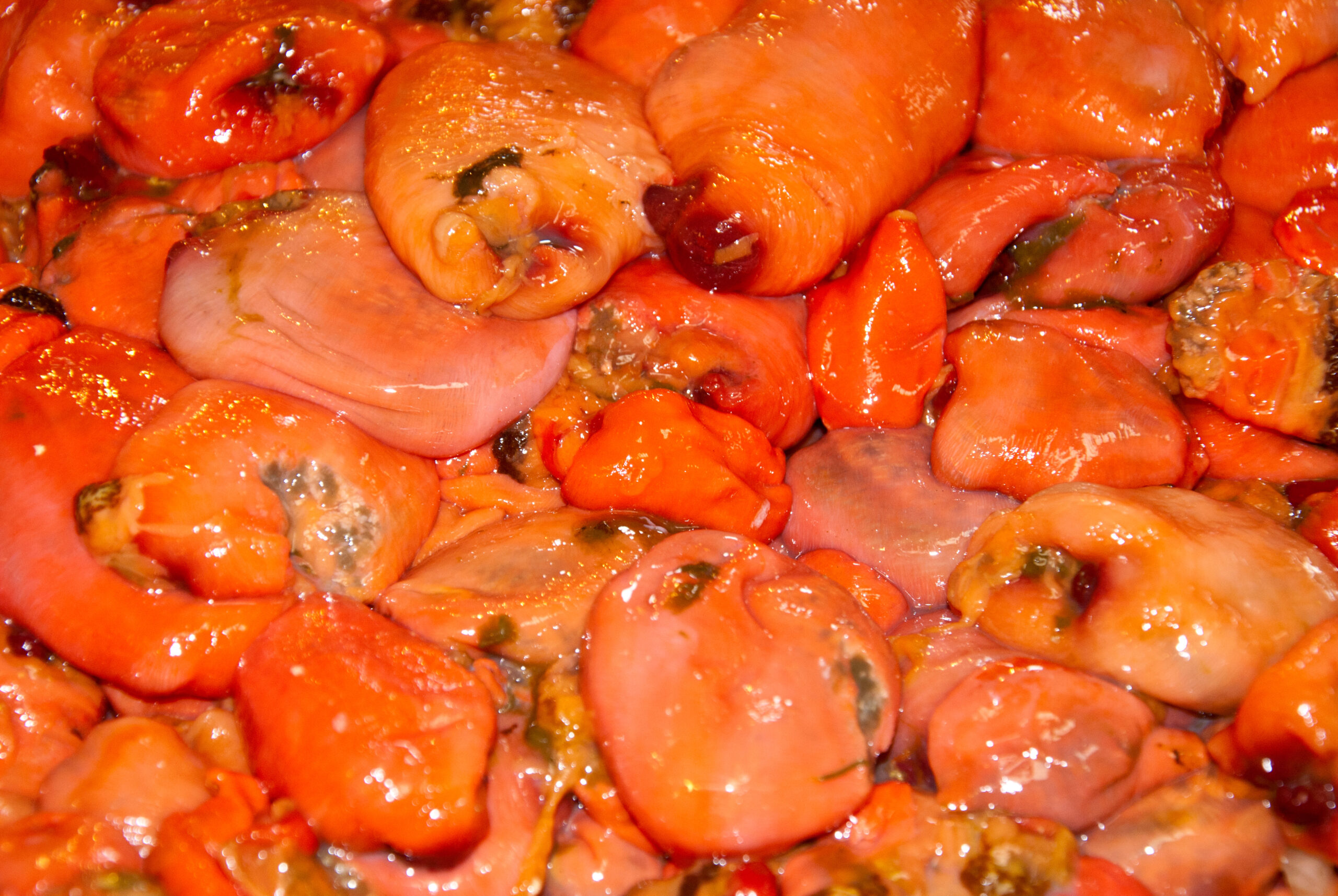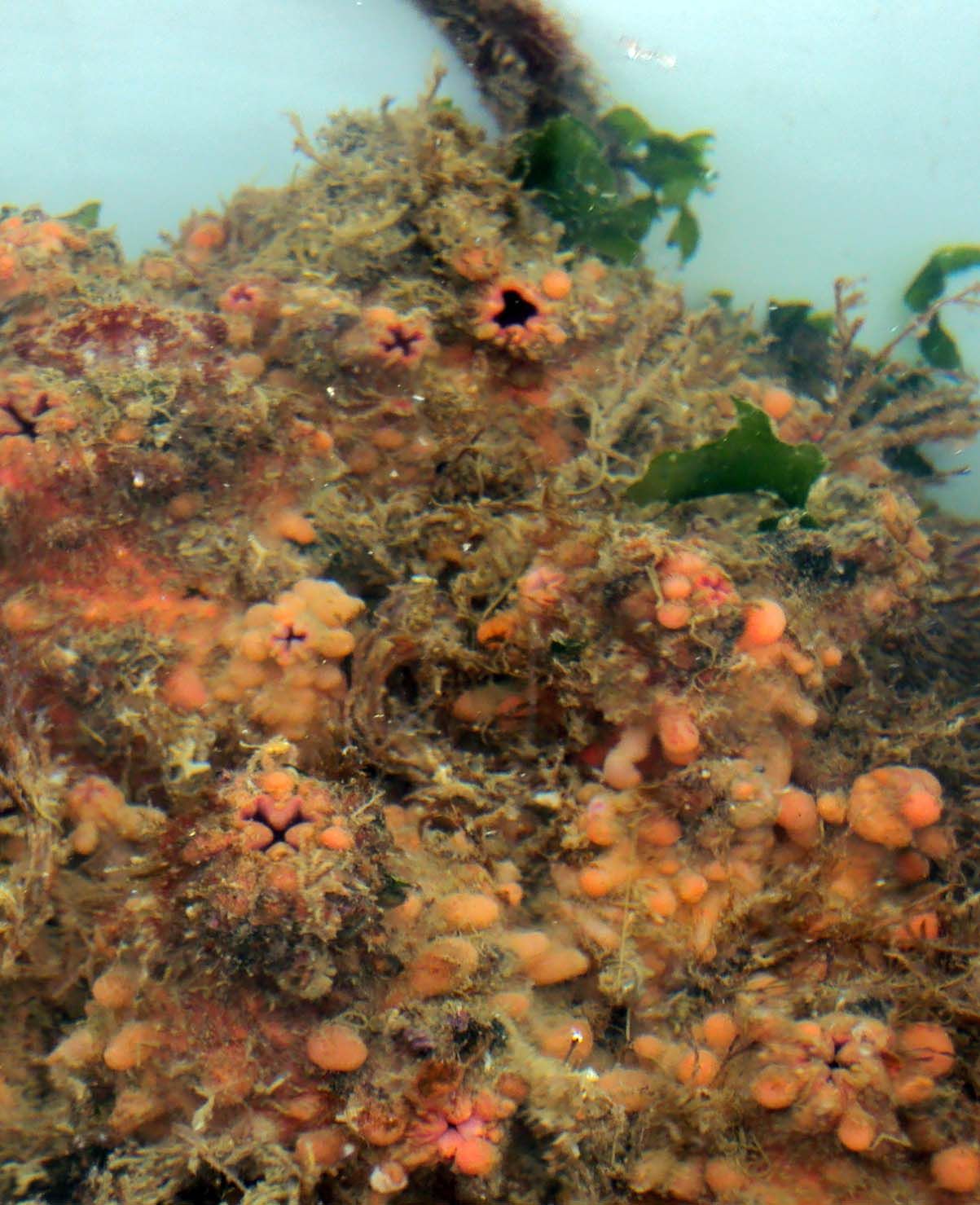04 May The Unknown History of Piure and Its Lineages in Chile: A Story of Time and Space
A series of publications in recent years have revealed the presence of three lineages of this peculiar marine invertebrate, distributed along the Chilean coast between Pan de Azúcar in Atacama and Ancud in Chiloé. The variability of these lineages appears to be influenced by temporal and geographical factors, as well as environmental conditions and phenomena such as El Niño. This knowledge could contribute to improving its management as a fishery and guide conservation efforts for this unique species.
A rock on the seafloor—that’s all one might see of the piure when diving in coastal waters between Peru and southern Chile, unless one has a trained eye to distinguish it from the surrounding stones. This tunicate invertebrate, a filter feeder that colors river markets, street fairs, seafood stews, and South Pacific dishes with its characteristic red hue, carries a family story that, until recently, remained unknown.
The piure (Pyura chilensis) is a species that lives from the lower intertidal zone down to depths of 70 meters, ranging from the central coast of Peru to southern Chiloé. Its appearance is deceptive; at first glance, it looks like a rock. But when opened by hand, a vivid red invertebrate about the size of a ping-pong ball is revealed. While well known among fishers and shoreline gatherers, it doesn’t share the popularity of other coastal species like loco or sea urchins—perhaps due to its strong metallic taste (which actually comes from the vanadium it extracts from seawater) and its appearance as a kind of living, filtering rock.
But to a group of researchers, its genetics are also special. Genetically, it differs significantly from mollusks and other invertebrates, and shows a closer relationship to vertebrates—including humans. But how much do we really know about the piure? What is its family history, origin, and what possible future scenarios lie ahead? In 2013, the piure caught the attention of two researchers: Pilar Haye, professor at the Universidad Católica del Norte and deputy director of the Millennium Institute for Coastal Socio-Ecology (SECOS), and Natalia Muñoz-Herrera.
They studied the spatial genetic structure of Pyura chilensis along the Humboldt Current. In their first investigation, the authors discovered that piure exhibits three well-differentiated genetic lineages (or mitochondrial haplogroups); two of them are widely distributed along the central-southern coasts of Peru and Chile, and a third is geographically restricted to the southern zone. In other words, three genetically distinct lineages with significant geographic variation.
In the northernmost locations, from the central coast of Peru to the Antofagasta Region, only lineage 1 (or Hg1) was present, and it was also the most abundant. In the intermediate regions, between the Atacama and Maule Regions (26°S to 36°S), individuals from a second lineage, lineage 2 (Hg2), were found alongside lineage 1. Finally, in southern locations, all three groups were present, with the third lineage (Hg3) being particularly abundant in Los Molinos, on the coast of Valdivia. The authors also attempted to estimate when these three lineages may have diverged from each other. According to the study, the three lineages of the species formed during the glacial cycles of the Pleistocene, as a result of isolation during glaciation events, coinciding with sea-level drops. In the subsequent interglacial periods, the populations were able to mix again, resulting in the current composition of three divergent mitochondrial lineages.
In-depth genetic study
According to the 2020 Statistical Yearbook of Fisheries and Aquaculture from the National Fisheries and Aquaculture Service (Sernapesca), there was a total landing of 1,729 tons of piure in 2020. This accounts for 5% of the total species landings in the country, highlighting the intense extraction of this resource for human consumption. For this reason, deepening the genetic studies of piure was part of the work of Nicolás Segovia, researcher at the Faculty of Marine Sciences of UCN, the Millennium Institutes SECOS and BASE, and the Institute of Ecology and Biodiversity (IEB).
Alongside Pilar Haye, also a researcher at UCN and SECOS, and Xavier Turon, researcher at the Center for Advanced Studies of Blanes (CEAB), they set out to explore new questions in a study of this species. The study, titled Time or Space? Relative Importance of Geographic Distribution and Interannual Variation in Three Lineages of the Ascidian Pyura chilensis in the Southeast Pacific Coast, examined the relative importance of temporal versus spatial components of genetic variation in P. chilensis, and whether its different lineages show the same spatio-temporal genetic structure patterns. In other words, what is the role of space and time in shaping these lineages of piure in Chile?
To investigate this, samples of P. chilensis were collected over five different time periods—in 2012, 2014, 2015, 2016, and 2017—by local fishers from Management and Exploitation Areas for Benthic Resources (AMERB) in six locations along the Chilean coast: Pan de Azúcar, Caleta Pajonales, La Herradura, Talcahuano, Los Molinos, and Ancud. More than 1,000 individuals were sampled in total, always from the same area within each location across all years. The sampling sites were selected based on the findings of Haye and Muñoz-Herrera in 2013 and included populations with differing proportions of the three piure mitochondrial lineages or haplogroups. Across the full dataset, a picture emerged of strong spatial differentiation but temporal stability in Pyura chilensis.
Nicolás Segovia, co-author of the article, highlights that “one of the most interesting results we found is that the first haplogroup (Hg1) is stable over time, and the differences we observed can be explained by variation between sites along the Humboldt Current. But the second lineage behaves differently. It’s relatively stable and homogeneous across space, but it changes a lot over time, which was surprising for us. If you look at the full data and don’t separate by lineage, you would say the piure’s pattern is very stable over time. But once we break it down, we see that this stability is lineage-dependent. That’s one of the key findings of this paper: that the influence of time depends on which lineage you’re looking at.
Time, space, and genetics
These results point to distinct patterns of genetic differentiation over time, which may reflect different adaptive potentials or variation in reproductive and dispersal traits—potentially as a response to extreme events such as El Niño. “This temporal variability is a very novel finding, especially because it’s so different between lineages. As far as we know, it hasn’t been reported before in a marine invertebrate that there are lineages within a species whose genetic structure changes over time,” explains Pilar Haye, co-author of the paper.
“The years with the greatest temporal change in genetic structure coincide with a year when there was a particularly intense El Niño event (2015), meaning the variability inherent to our coast induces changes. This new perspective speaks to the dynamism of genetic structure and how natural events may be shaping genetic diversity over time. From an evolutionary point of view, it’s fascinating that two lineages within the same species can display such different temporal patterns,” she adds.
Segovia, in turn, highlights a human-related factor. “Adult piures are like rocks—they don’t move. Therefore, anthropogenic transport, where ship hulls act as vectors, promotes mixing of individuals from different geographic areas within each lineage. This helps explain why the most abundant lineage is relatively homogeneous both spatially and temporally. For example, the third lineage, which is found mainly along the Valdivian coast—where there are fewer fishing routes—is less mixed with other lineages compared to other geographic areas, and this may be due to that specific factor”.
Linages: key information for planning and conservation
According to the authors, these studies provide relevant information that should be considered when planning conservation strategies for this species. In that context, the research urges caution when attempting to draw general trends from species that are clearly differentiated into lineages. It also encourages conducting separate analyses of sub-specific genetic lineages whenever possible, since, for example, piure varies in its genetic structure across space and time—but this depends on the lineage (hence the title of the paper).
“Any management or conservation measure for this species should take this information into account—especially in cases involving aquaculture, where juveniles are transported, or restocking efforts. For the sustainability of the species, we need to safeguard these processes and avoid anthropogenic transport. In this study, we looked at the underlying genetic background of individuals, and it gives us a map that raises concerns if individuals are going to be moved or cultivated from just anywhere,” says Pilar Haye.
This research is part of a broader series of studies on this species conducted by this group of scientists, who have not only examined the influence of time and geographic distribution on the different lineages, but also the impact of environmental factors and natural selection on patterns of genetic differentiation. These studies undoubtedly enhance our understanding of this unique species (Segovia et al. 2017, Segovia et al. 2020). “Scientific evidence of this level allows us to develop informed conservation strategies. And at SECOS, what we want to do is to translate our science and foundational knowledge into more concrete socio-ecological issues,” adds Segovia.
This research on the piure—a unique species that is sometimes overlooked in the social imagination of fishery resources—can be applied to other species, where spatial and temporal variability could help inform conservation and management strategies. For instance, areas with higher genetic diversity and greater connectivity to other populations—such as those in southern Chile along the Valdivian coast—are better suited for extraction than areas with low genetic diversity, such as in northern Chile. “Our discipline—evolutionary genetics—is a powerful tool that helps us understand how species in the AMERBs are connected,” Haye concludes.




Referencias
Haye, P. A., & Muñoz-Herrera, N. C. (2013). Isolation with differentiation followed by expansion with admixture in the tunicate Pyura chilensis. BMC Evolutionary Biology, 13(1), 1-15.
Segovia, N. I., Gallardo-Escárate, C., Poulin, E., & Haye, P. A. (2017). Lineage divergence, local adaptation across a biogeographic break, and artificial transport, shape the genetic structure in the ascidian Pyura chilensis. Scientific reports, 7(1), 1-12.
Segovia, N. I., González-Wevar, C. A., & Haye, P. A. (2020). Signatures of local adaptation in the spatial genetic structure of the ascidian Pyura chilensis along the southeast Pacific coast. Scientific reports, 10(1), 1-14.
Haye, P. A., Turon, X., & Segovia, N. I. (2021). Time or space? Relative importance of geographic distribution and interannual variation in three lineages of the ascidian Pyura chilensis in the Southeast Pacific Coast. Frontiers in Marine Science, 413


